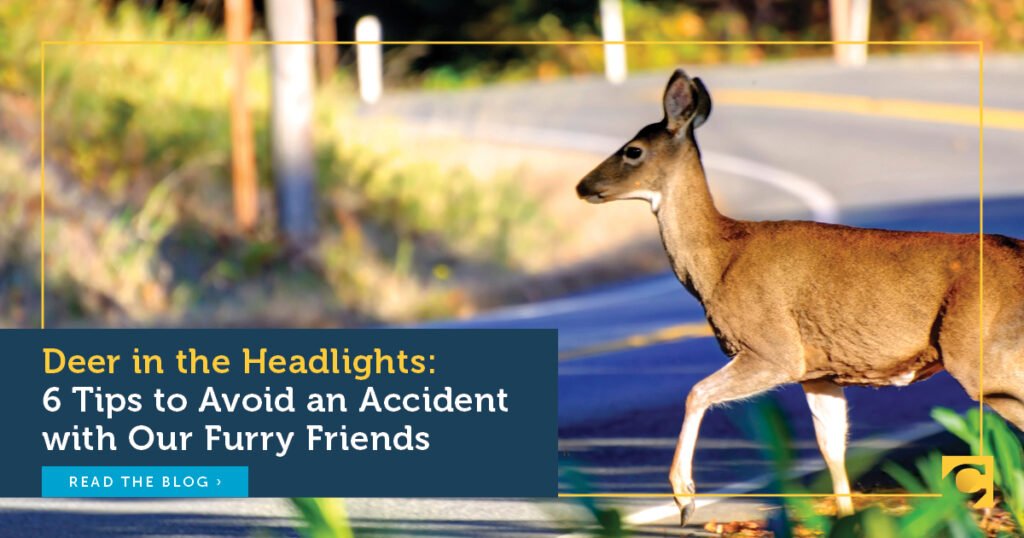Over the previous a number of years, there was a lot debate about the advantages and downsides of daylight financial savings time. One argument towards turning clocks again is it reduces accidents from vehicles hitting deer.
Training on potential deer risks empowers you to turn into a safer driver—whether or not driving at dawn or within the darkening hours of nightfall. Learn on to be taught how one can keep away from turning into a deer collision statistic.
The Information on Deer Injury
“Central has seen 5,000 deer-related losses since 2019.”
—Tali Helton, Private Strains Insurance coverage Product Supervisor at Central Insurance coverage
On common, the U.S. experiences round 2.1 million deer-vehicle collisions annually. These incidents are answerable for over $10 billion in financial losses in addition to 59,000 human accidents and 440 human deaths.
Vehicles hitting deer represent the largest collision category involving human and car prices. The typical prices of a deer-related collision are staggering:
- $1,840 in car restore prices
- $2,702 in medical prices
- $125 in towing and regulation enforcement providers
- $50 for carcass removing and disposal
Prices improve considerably if a automobile collides with a bigger animal, akin to an elk or moose.
When Time is Not On Your Aspect
The prevalence of vehicles hitting deer is 14 times greater through the two hours following sundown. Whereas people regulate their schedules based on the time change, animals don’t.
Transferring our clocks again in November will increase highway site visitors quantity throughout low-light hours, making a higher chance of vehicles hitting deer. White-tailed deer mating and migration season, which coincides with this time, poses further dangers. Deer are exceptionally lively and prevalent throughout this era, creating additional collision potential.
One study reported a 16% improve in deer-related car collisions when clocks transitioned to plain time within the fall. Whereas this improve could not appear substantial, it could cut back almost 36,000 collisions, 2,000 human accidents, and 33 human deaths. Moreover, it may save nearly $1.2 billion in collision prices associated to vehicles hitting deer.
The way to Keep away from Hitting a Deer
The best frequency of vehicles hitting deer happens within the early morning (5 a.m. to 9 a.m.) and the night (4 p.m. to midnight) when deer are most lively. Nevertheless, most of us can’t restrict our driving to exclude these timeframes. Thankfully, you’ll be able to take some easy steps to scale back your threat.
1. Keep vigilant whereas driving close to fields or wooded areas.
Though you will discover deer nearly anyplace, train further warning when driving by means of closely wooded areas. Search for the reflection of their eyes in your headlights on the facet of the highway.
2. Make the most of your excessive beams every time doable.
Excessive beams may help illuminate deer extra successfully and make recognizing the reflection of their eyes simpler. Remember {that a} deer crossing your path could freeze in your headlights. Shortly flip them off and honk your horn to scare the deer away from the highway if it’s secure.
3. Look ahead to deer crossing indicators.
Whenever you see a deer crossing signal, pay further consideration to your environment. These indicators are positioned in areas identified to have a excessive deer inhabitants.
4. Keep away from swerving.
If a deer enters the roadway, apply the brakes and chorus from swerving. Deer sometimes transfer out of the best way. Swerving could put you again within the deer’s path, and sharp, sudden turns improve the chance of shedding management of the car and colliding with one other automobile, tree, or ditch.
5. Be looking out for extra deer.
When you spot one deer, there are doubtless others close by. If a deer jumps in entrance of your car, be ready for the likelihood that extra deer could comply with intently behind.
What to Do If You Hit a Deer
Even with one of the best preparation, accidents occur. Take the steps beneath to make sure your security and the protection of different drivers on the highway.
- When you do hit a deer, transfer off the highway the place it’s secure to take action.
- Name within the collision and comply with any particular state guidelines or tips. Reporting the incident to the correct authorities ensures they’ll take acceptable measures to take care of highway security for different drivers.
- Assess your automobile for injury. Nearly all of deer-related collisions are estimated to trigger car injury. It’s vital to consider your automobile for injury earlier than returning to the highway.
Interested by Your Complete Protection?
Complete protection, relatively than collision protection, covers deer-related collisions as a result of these incidents are thought of past the motive force’s management. Verify your coverage to make sure you have enough complete protection in place, or be taught extra about Central’s private auto protection choices here.
00
